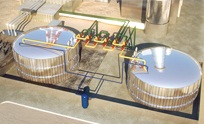Nur Energie using BrightSource tech in new Greek solar plant
 Yesterday, Nur-MOH, a solar power producer in the Mediterranean region, announced that it secured an Electricity Generation License to construct a 38-megawatt solar farm on the island of Crete in Greece. Nur-MOH is a joint venture between Nur Energie and Motor Oil Hellas.
Yesterday, Nur-MOH, a solar power producer in the Mediterranean region, announced that it secured an Electricity Generation License to construct a 38-megawatt solar farm on the island of Crete in Greece. Nur-MOH is a joint venture between Nur Energie and Motor Oil Hellas.
The plant will use concentrated solar power technology provided by U.S.-based company BrightSource energy and will power 13,000 homes on the island. This is the first European project that will use Brightsource’s proprietary LPT 500 solar technology, which uses thousands of small mirrors—or heliostats—to reflect sunlight directly onto a boiler, producing steam. After the steam is piped to a turbine, it is redirected back into the system, using 95 percent less water than traditional wet-cooled solar thermal technologies, according to a press release.
"After careful consideration, we selected BrightSource's LPT 550 energy system because of the technology's superior performance, low impact environmental design and ability to be customized to Crete's unique energy load profile," said Kevin Sara, founder and CEO of Nur Energie, in the release. "When completed, this will be the largest tower installation and the most technologically advanced CSP plant in Europe."
Greece has been in headlines for the past year, but not for its renewable energy generation. The government is broke. But according to Nur Energie’s Investor Relations and Communications Director Marleen Franke, those financial woes haven’t hampered the clean-energy sector.
“The financial crisis in Greece is more about the state’s own finances and has not affected the economy at large,” said Franke. “Clean energy is a top priority of the Greek government, which has attracted significant foreign investments in this sector.”
Now that the license has been issued, Franke said, the funding negotiations are underway.
"Nur-MOH is currently engaged in discussions with Greek and other European financial institutions seeking funding for the project and have received positive feedback from the financial community,” said Franke.
And even if the country’s financial troubles prevented subsidies for solar installations, Franke said, it wouldn’t have affected this project’s funding.
“The market support scheme, such as the current feed-in-tariff for solar thermal energy in Greece, is 264.85 €/MW, which is guaranteed for 25 years and is not linked to public funding, but consumer electricity bills,” said Franke.
Once the plant is completed, Nur-MOH will begin a power-purchase agreement with local utility Public Power Corporation. According to Franke, the company already signed a lease for the project’s site for the duration of the PPA.
But there’s still plenty of red tape the company has to go through before Cretans are reading Epimenides by a solar-powered lamp.
“Following the Generation License, the developer must obtain Grid Connection Terms and the Environmental Permit,” said Franke. “Both of these milestones are the two major prerequisites to the Installation License, which precedes the PPA. Then a Construction Permit can be issued, and finally after construction is complete, an Operation License is granted for the plant to be commissioned.”
Image courtesy of BrightSource Energy.



